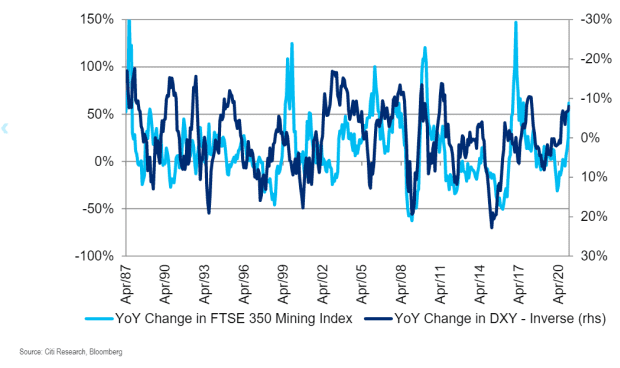It was a very impressive 12 months for the world’s top miners.
The FTSE 350 mining index 156995,
– which includes diversified mining giants Rio Tinto RIO,
BHP Group BHP,
Anglo American AAL,
and Glencore GLEN,
– returned 46% to shareholders in the past year, according to FactSet, compared to the 7% drop for the broader FTSE 350.
The sector is benefiting from an increase in the value of the metals they discover. First month copper HG00,
futures jumped 62% in the last 12 months, SI00 silver,
earned 51% and PL00 platinum,
added 32%.
And there are two major trends that should further boost the sector.
The first is the decline in the DXY dollar,
A weak dollar environment increases the purchasing power of major commodity-consuming markets, notably China, points out Ephrem Ravi, an analyst at Citigroup. A lower dollar also helps to loosen global monetary conditions, since much of the world’s corporate debt is denominated in dollars.
As the graph shows, there is generally a strong correlation between the shares of the mining sector and the variation of the dollar.

Another boost comes from the increase in copper over gold. The copper / gold ratio has risen in the last year, which implies optimism regarding global growth, says Ravi, from Citi. Copper is needed for manufacturing and construction, while gold is often used as a safe haven in financial pressure.
Jeffrey Gundlach, chief executive of DoubleLine Capital and called the bond king, said the copper / gold ratio closely follows US government bond yields, which tend to increase as the economy improves.
According to Ned Davis Research, citing data dating back to 1995, the European metals and mining industry outperformed the market by an average annual gain of 9.7% when economic prospects are improving, but underperformed by 7, 4% per year when the economic outlook is deteriorating.
Mark Phillips, European equities analyst at Ned Davis Research, says it makes sense for miners to experience ups and downs. “A boom will start when an increase in demand for commodities raises prices while short-term supply remains relatively fixed. As high prices persist, this encourages companies to invest in new projects that were previously uneconomic, ”says Phillips.
“However, long lead times usually mean that many companies invest in new projects at the same time, resulting in cost pressures and an oversupply, which can occur at a time when demand starts to decrease. This results in falling prices and mining and metals companies at the top of the cost curve close the market, ”he adds.
Super cycle talk
Also behind the gains are some rumors of a commodity super cycle. This basically means a cycle that lasts decades and moves commodities as a whole. “The commitment of many nations to be carbon neutral and less energy intensive by 2050-2060 requires significant investment in infrastructure that will be commodity intensive. Structural commodity price models have shown that at each major stage of economic development: agricultural, industrial and services, the use of commodities can change, increasing the likelihood of a super cycle in the early stages of development, ”said Daniel Jerrett, director of investments from Stategy Capital, which started a global macro fund last month.
What is said in the market is inflation, fueled by a loose monetary policy and aggressive fiscal spending. Analysts at Variant Perception, a research firm, have argued that rising inflation risks, the need to protect against them and “generically cheap” prices will lead to a commodity super cycle. Among the major banks, JPMorgan also endorsed the view of the commodities super cycle.
It is lonely to bet against the miners at the moment. There are no short positions against the large mining companies that are large enough to be reported, according to daily updates from the Financial Conduct Authority.
But there are some with differing points of view. Ben Davis, an analyst at Liberum Capital, has a sales rating at Rio Tinto and a hold at BHP. The dollar’s weakness, he acknowledges, may help the bullishness continue, “but it looks like there’s a lot of that in the price.” And Davis does not believe that commodities are in a super cycle.
But Davis predicts a slowdown in Chinese credit, which will soon have an impact. Loan growth gradually decelerated from 13.2% over the previous year in June to 12.7% in January.
“The reduction in Chinese credit will begin to be felt in the demand for commodities and, although restocking in the rest of the world is a very powerful force, it is unlikely to last beyond the middle of the year. The first and biggest beneficiary of this cycle was iron ore and, for this reason, BHP and Rio Tinto have the most immediate disadvantages in our opinion, ”he said.
